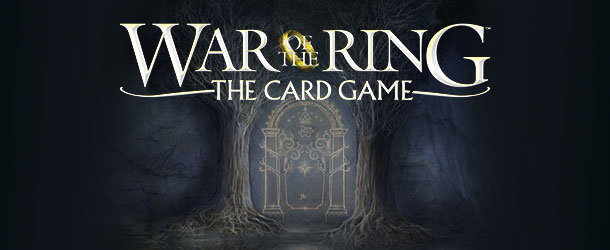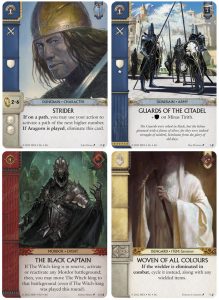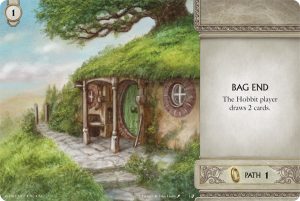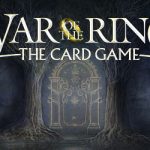War of the Ring - The Card Game is a multi-player game inspired by "The Lord of the Rings" book trilogy, developed to give to players similar emotions of the acclaimed War of the Ring board game, while being more portable, faster to play, and easier to access. In War of the Ring – The Card Game, 2 to 4 players compete on two teams, the Shadow against the Free Peoples. This article reviews some of the basic strategies for playing War of the Ring: The Card Game. It is written assuming you’re playing the “Trilogy scenario” with four players, two on each team: Free Peoples vs. Shadow.
Gameplay Overview
Each player starts with a unique deck of 30 cards, representing key characters, armies, items, and events featured in the Tolkien’s Lord of the Rings trilogy. Cards belong to different factions, like Hobbit, or Rohan, which controls where they can fight, among other things.
Game proceeds over nine or fewer rounds. At the beginning of each round, the starting player will activate a battleground and a path. Battlegrounds are where the armies of Middle Earth clash, like Helm’s Deep; paths are places visited by the fellowship on their journey to fulfill its quest.
The main part of the round is the Action step, where players take turns playing cards or taking other actions. Cards may be played to the path or battleground; or “in reserve”, on the table in front of you. In addition, players may have a number of options other than playing a card, like moving a card from reserve, using a card’s special ability, or passing, to name the most common.
Combat is resolved at the end of the round, except when a new path is activated mid-round. Whichever team has committed more forces, as measured by attack and defense icons, wins and scores the Victory Points associated with the location. At the end of the round, if neither team is ahead by 10 points, you’ll draw some more cards and start the next round, unless you’ve completed the final path, in which case the team with more Victory Points wins.
That’s a very rough overview but should hopefully get you through the rest of this article if you haven’t seen anything else about the game before.
What card should I play?
Being presented with a hand full of unfamiliar cards can be daunting. To make your task a bit trickier, you’ll only be playing about the half the cards you draw, since every time you play a card, you’ll have to put a different card in the cycle pile. Your cycle pile will be “recycled” to replenish your draw deck when its depleted.
You’ll first want to consider if you think your team can win either or both battles, as you don’t want to commit forces to lost causes; or over-commit to an easy victory when you could have placed cards in reserve for next round.
Always check if you can pass, but it’s not always the best idea to pass! You may pass when you have fewer cards than each of your opponents, or when your hand is no larger your carryover limit (usually 2 cards). Forcing your opponents to play before you may provide a critical edge - but make sure you don’t miss the best timing for the situation!
Who’s winning?
Yes, at the end of each round you’ll compare the scores – but that’s only part of the story. In some games, one team may pull ahead early, but if they consumed too many resources– for example, the cards they lost in combat, never to return - they might be unable to maintain the lead. Pay special attention to cards that can activate battlegrounds and paths, as these can lead to big point swings. Sometimes it’s tricky to see what will happen until it’s all over!
Individual Player Tips
- Frodo (Hobbits, Wizard, Rohan, Dwarf): Gandalf, Sam, and Frodo are the key characters in this deck. Use Gandalf the Grey to advance to the next path, and then use Gandalf the White as the decisive card in a battleground fight, especially mounted on Shadowfax. Meanwhile, make sure you prepare Rohan for battle by mustering a force in reserve.
- The Witch King (Mordor): The Witch-king and the Mouth of Sauron are key characters in this deck, but all your Nazgûl are useful. Make sure you use some of your actions to build an army large enough to defeat Minas Tirith and Lórien. Early on you may need to contest the path to keep the Free Peoples from accumulating too many Victory Points, but don’t ignore the Nazgûls’ special abilities.
- Aragorn (Dúnedain, Elf): Strider and Aragorn are the key characters in this deck. Strider, like Gandalf the Grey, can help the Free Peoples move quickly past a dangerous path. Bring Aragorn in later to draw cards and lead in a crucial battle. Powerful elves like Elrond and Galadriel provide game-long benefits with a low playing cost since they allow you to draw a card.
- Saruman (Isengard, Monstrous, Southron): Saruman is naturally your most important card. Playing this deck involves carefully controlling the chaos of the Monstrous cards to hinder the Free Peoples, while accumulating Isengard armies in preparation for battles like Helm’s Deep and Isengard. Southron Armies need to be thoughtfully managed for maximum effectiveness, especially to activate additional battlegrounds when you think you can win them.
This article was originally published by Meeple Monthly magazine, issue 115 (October 2022).













